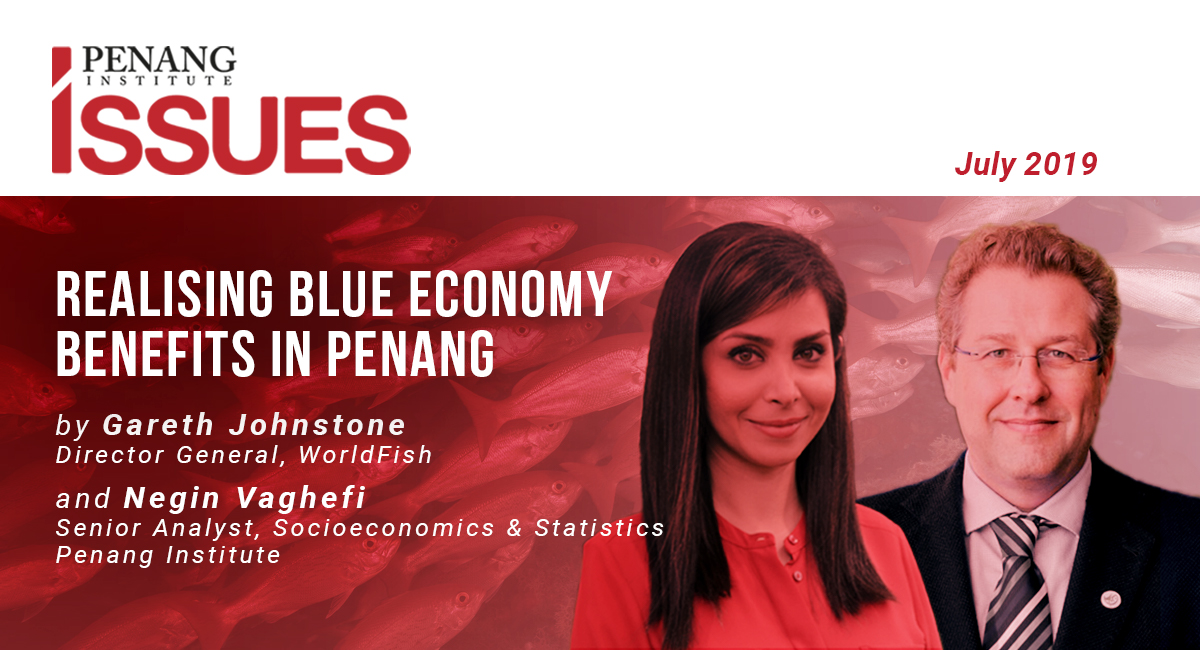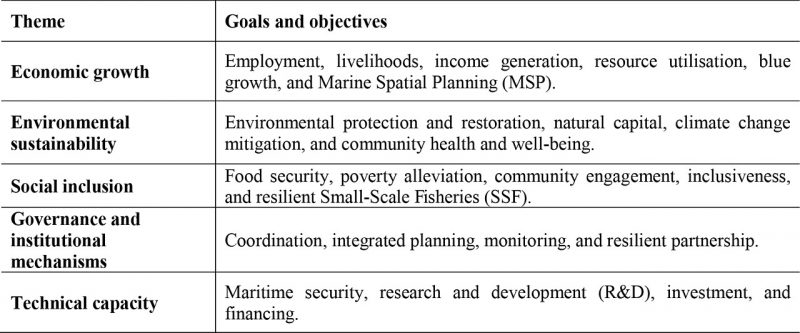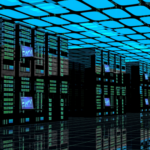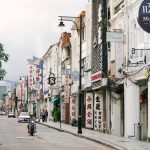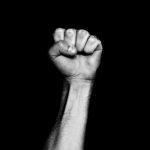Executive Summary
- Blue Economy is aimed at the sustainable development of ocean and water resources. Realising Blue Economy benefits in Penang can lead to better and new job creations, achieve higher rates of economic growth, and secure biodiversity and sustainable development obligations
- Areas where benefits can clearly accrue are the following:
- Small-scale fisheries – inclusive management of fish stocks and aquatic food ecosystems
- Sustainable aquaculture – supplying low-impact, affordable, nutritious and safe aquatic foods and fish
- Ecotourism – providing new socially responsible and environmentally friendly jobs and economic opportunities
- Maritime transport – integrating sea and waterways travel and transport of the island and coast, and reducing congestion of urban transport systems
- Safe and renewable energy production – making energy cleaner through solar, wind, wave and tidal resources in Penang’s coastal and marine environment
- Marine biotechnology – biofuel, dietary supplements, and medical treatments from aquatic resources such as seaweeds
- To fully realise the potential of the Blue Economy in Penang, however, a new vision is needed that brings together the public and private sectors, as well as the community into a facilitated dialogue that transforms how we use land and water resources sustainably
Introduction
Largely driven by a growing population in search of new and sustainable sources of food, economic growth, and technological advances, the ocean has come to represent a new economic frontier for actors of different interests across the public and private sectors.
The term “Blue Economy” has been coined to describe how ocean-based economic activities can be developed sustainably to optimise the benefits and minimise the negative impact on the environment and on society. Discussions on the Blue Economy are typically focused on high-tech innovations, large-scale aquaculture systems, and mining the ocean’s depths, which together form an increasingly relevant element of the Blue Economy. However, the immediate impact of the Blue Economy comes from a greater focus on integration, coordination and planning, and adding value to existing systems, sectors and tools to ensure sustainable development.
As a state, Penang can gain much by engaging with the Blue Economy, and by sharing and exchanging ideas, policies, technologies and practices. The state’s economy, culture and environment can be defined as much by the water that surrounds the island and abuts its shoreline as it can be by the land on which its people live, work, and enjoy its rich culture. Its coastal waters, rivers, lakes, wetlands, coral reefs and estuaries offer huge opportunities for job creations, healthier diets and better livelihoods. All these can stimulate innovation and provide for a sustainable and inclusive Blue Economy.
However, a main challenge for the Blue Economy is to ensure that everyone benefits, such that we not only protect, produce and prosper from marine and aquatic resources, but also share the gains.
1. Defining the Blue Economy
In general, the Blue Economy refers to a sustainable use of aquatic resources for economic growth, to the improvement of human well-being and social equity, and to protect against negative environmental externalities such as pollution and climate change. This concept emerged in response to the 2012 United Nations Conference on Sustainable Development (UNCSD), “Rio+20”.
The Blue Economy is thus part of a global dialogue on specific recommendations for achieving Sustainable Development Goal (SDG) 14, “Life Below Water”, which seeks to conserve and sustainably use the oceans, seas, marine and aquatic resources. Discourse on SDG14, which has been guided by conservation objectives and large economic interests, is shifting and greater emphasis is now being placed on the Blue Economy generating employment, eradicating poverty and hunger, spurring entrepreneurship, and creating better opportunities for men, women, youth and indigenous people.
According to the Organisation for Economic Co-operation and Development (OECD), oceans contribute approximately US$1.5tril annually to the overall economy, and this will more than double by 2030. Direct employment in the Blue Economy is estimated at 80 million with around 60 million people employed in fisheries and aquaculture, more than half whom are employed by capture fisheries work in small-scale operations. The oil and gas sector employs approximately 1.8 million; and tourism about 8 million people directly.
Fisheries, aquaculture, tourism, shipping, biotechnologies, maritime security, mining, oil and gas, renewable energy and ecosystem services all compete for coastal and ocean space. Understanding the different economic, social and environmental costs and benefits, as well as the risks of each sector in sustaining and conserving aquatic resources, is necessary in making meaningful inter-sectoral trade-offs.
The Blue Economy aims to achieve this through various tools and assessments that incorporate the real value of the ocean’s natural capital into all aspects of economic activities. By reflecting the real value of the ocean’s environmental services, the Blue Economy approach optimises the benefits while minimising the costs between different sector activities in the oceans.
The Blue Economy concept comprises five key themes, namely economic growth, environmental sustainability, social inclusion, governance and institutional mechanisms, and technical capacity. Goals and objectives of each theme are presented in Table 1.
Table 1: Goals and objectives of the Blue Economy
2. Opportunities and challenges
Implementing the Blue Economy requires good data and analysis of respective ocean-based sectors, including better understanding of their potential contributions to revenues, people’s welfare and ecosystem services. Many sectors have poor data collection systems, and this undermines their potential to benefit from the Blue Economy, or may even exclude them from participation. Of note are capture fisheries, in particular small-scale fisheries where the intrinsic value of the sector is poorly understood and the economic analysis weak. Where there are better data on fisheries such as in some of the large ocean States of the Pacific, the Government together with local fish workers have been able to adapt management practices that have resulted in sustainable job growth and better policies and governance.
Even when data are scarce, a Blue Economy approach can be employed to improve planning and coordination between sectors. Several countries have been successful in this approach, including South Africa, Kenya, the Seychelles, Mauritius, Madagascar and the Caribbean. Strategically integrated planning and coordination are the key characteristics in such cases. Kenya, the Seychelles, and South Africa have created departments for the Blue Economy that integrate responsibilities to coordinate inter-sector planning into the government’s institutional structures. In Kenya the Ministry of Fisheries brings together key parties responsible for transport, tourism, shipping and environmental protection to form an inter-agency committee that reports to the Cabinet. The committee has undertaken a cross-sector analysis with the aim of unlocking jobs and has produced a roadmap for the Blue Economy. This improved communication between agencies has resulted in several public-private partnerships being established.
In the Seychelles, when the country graduated to become a high-income country, it stimulated the development of an innovative financial instrument called the Seychelles Blue Bond, which was made possible due to a World Bank guarantee and which helped to raise US$15mil. Funds have been used to finance sustainable increases in productivity through better management of fisheries, including measures to rebuild stocks, restructure fishing capacity and support post-harvest value adding.
Japan is on board regarding the Blue Economy and supports what is termed as the sixth industry development. This has resulted in investments in several new fish landing sites to provide quality market and retail space that brings consumers to fish production areas. The use of “green-lanterns” indicates to consumers when a retailer is selling local produce. The approach has been particularly successful in creating jobs and diversifying the aquatic resources-based economy.
3. Priority areas for a Blue Economy in Penang
The Blue Economy approach also helps to minimise environmental degradation and pollution; restore and conserve biodiversity and natural resources; protect against overfishing; and facilitate the transition towards a low-carbon economy and a renewable “blue” energy generation. Essentially, it helps to ensure an ecosystem-based management approach to human activities in the sea, ocean and coastal areas.
In Penang transitioning to a Blue Economy will require investment in economic, social and environmental knowledge and technologies, as well as people to fully unblock its innovative potential. The current state of marine and coastal ecosystems in Penang is in need of better management of human activities to sustainably develop natural resources and the economy.
Adoption of the Blue Economy approach will promote the importance and value of marine and aquatic resources, and allow for a greater focus on gender equality not only in developing low-skilled jobs in post-harvest and processing, but also in leadership and technical skills that are currently underrepresented in the field.
This approach can actively support small-scale businesses in diversifying livelihood opportunities and contribute to food security and nutrition through fisheries, aquaculture and other food processing sectors. By working together with coastal communities, minorities and vulnerable members of society, an inclusive and sustainable economic growth can be better assured.
Relative to its land size, Penang has vast marine and aquatic resources for boosting economic growth. Traditional fishing, shipping and maritime trade have historically dominated ocean activities in Penang. But its Blue Economy potential can be significantly expanded into alternative, emerging and new sectors (Table 2), and contribute towards resilience-building against external shocks, be it economic, social or environmental.
Table 2: Blue Economy key sectors in Penang
Resilient small-scale fisheries
Small-scale fisheries (SSF) are at the heart of Penang’s fisheries sector, but their contribution is often marginalised and undervalued. In fact, marine and coastal waters are specific locations where SSF activities take place, making their long-term sustainability and viability important for fish workers’ livelihoods. It is also important to note that under Blue Economy objectives, the social dimension of fisheries and fish workers’ concerns are represented and recognised in an inclusive and sustainable manner.
Sustainable aquaculture production and public health
The sustainable supply of fish through aquaculture, capture fisheries and reduction in fish waste and loss in the value chain is a cornerstone for the Blue Economy in Penang. Increasing the supply of affordable, nutritious, safe and high-quality fish and aquatic foods to meet growing demand is essential in transforming these sectors into sustainable food systems. SSF accounts for 50% of the world’s marine fish catch for human consumption, with the other half now coming from aquaculture.
Asia accounts for 84% of all individuals employed in the fisheries and aquaculture sector worldwide, and 75% of the global fishing vessels.[1] By 2030 Asia will consume 70% of the world’s fish and will export fish valued at US$136bil.[2] In Malaysia fish contributes around 44% of the total animal-sourced protein intake.[3] Malaysians are among the world’s biggest consumers of fish (56.9kg/capita/year) – far above the world average of 20.3kg per capita.[4] However, the country’s supply of fish cannot meet domestic consumption. In 2018 Malaysia imported about 224,578 tonnes of fish valued at RM1.7bil.[5] In 2017 Penang’s food fish sector produced 96,970.4 metric tonnes, valued at RM1.4bil (the third highest wholesale value in the country). Yet, domestic demand for fish exceeded that of local supply.
To increase the supply of aquatic food sources from freshwater and the seas without damaging further these ecosystems, requires a combination of better fisheries management, investment in sustainable aquaculture and a reduction in fish loss and waste. Globally, one in three fish caught are lost in post-harvest processing. Aquaculture can help to minimise the pressure on wild stocks and produce fish at affordable prices for domestic markets, and as high value seafood for tourism and export markets. At the same time, better management practices in capture fisheries can improve resource sustainability and enhance local supplies with new wealth creation opportunities through value adding in fish processing and retail, providing new job opportunities for women and youth.
Sustainable aquatic foods and fish production systems not only provide economic benefits; they also help maintain a healthier population particularly in reducing non-communicable diseases such as diabetes and heart diseases. In 2017 about 1,409 and 10,284 persons died of diabetes and heart diseases respectively in Malaysia.[6] The risk of obesity is increasing in the country. In fact, Malaysia has the highest obesity rate among ASEAN countries, with nearly 14% of the citizens under the “obese” category.[7] A Blue Economy can help to promote good public healththrough the supply of nutritious and safe aquatic foods, fish and fish products that are high in micronutrients and essential fatty acids. Low seafood consumption during pregnancy increases the risk of the foetus’s sub-optimal neuro-developmental outcomes, including poorer cognition and fine motor skills.[8]
Sustainable tourism
In 2016 travel and tourism generated US$7.6tril – 10.2% of the global GDP – and supported one in every 10 jobs in the world.[9] About 80% of all tourism takes place in coastal areas, with beaches and coral reefs among the most popular destinations.[10]
In Penang the tourism industry is the second main source of income generation, after manufacturing. Its coastal and marine tourism represents an important share of the tourism industry, and brings jobs and economic growth to the state. A case in point: cruise tourism in Penang is growing considerably; in 2017 the number of international cruise ships that docked in Penang and the number of passengers increased by 88.2% and 84.2% respectively, a remarkable boost from 2016.
The tourism industry is extremely dependent on environmental quality to attract visitors. However, uncontrolled and irresponsible mass tourism may put pressure on urban centres and environmental resources, including the degradation of valuable habitats such as coral reefs, wetlands and mangrove forests, increased greenhouse gas emissions, and significant consumption of resources including water and energy, and waste generation. Adopting a Blue Economy approach whereby ecosystem services are properly valued and incorporated into development planning can help diversify the tourism industry to promote low-impact activities, such as ecotourism, while minimising the negative impacts of mainstream tourism.
Global and local maritime transport
About 90% of all goods in the world are transported by sea.[11] Five out of the top six shipping economies in the world are located in East Asia, along with nine of the top 10 busiest container ports (by volume).
Malaysia stands to benefit from the continued growth in seaborne trade, and is poised to be the main fish exporter due to its well-developed port cargo transport facilities for shipping to the main East Asian markets, and its close proximity to the Indian Ocean. Penang is a major transportation and logistics hub in the northern region and the Indonesia-Thailand-Malaysia triangle, which can facilitate fisher workers and farmers in gaining access to the global market.
As an island, Penang can also benefit from greater connectivity to provide maritime transportation solutions to alleviate urban traffic congestion; and at the same time, connect consumers with producers to buy and consume fish, promote commerce and enjoy the rich culture of the coastal communities at fish landing sites.
Safety, renewable energy and resource-based industries
The security and safety of maritime resources in Penang are essential for trade, communication, and job and wealth creations. However, security challenges have escalated for ports, offshore installations and ships in recent times endangering the crew, ships, cargo, marine life and other investments. To that end, collaboration – and this includes ASEAN cooperation – between different Blue Economy stakeholders is needed to develop new regulations, enforcement and technologies that can deter a range of threats and criminal activities. High priority needs to be given towards eliminating illegal, unregulated and unreported (IUU) fishing that threatens the sustainability of the world’s fisheries, and that costs the industry an estimated US$23.5bil annually.[12]
As energy consumption in Penang continues to climb, alternatives to traditional fossil fuels are needed. Great potential exists for the development of renewable energy such as solar, wind, wave and tidal energy resources in Penang’s coastal and marine environment. Ocean currents and wave energy can be captured to provide a sustained source of energy, while wind and solar farms can be placed in the ocean to relieve pressure on the land.
The sea can provide much of the raw materials for aquatic resources-based industries and the food manufacturing sector. Being a manufacturing- and services-oriented economy and a main hub for exports, Penang is able to benefit from increasing its seafood supplies.
High-tech and biotech marine services
A significant market exists for companies providing marine technology and environmental services, including oil spill response, environmental consulting, marine scientific services and IT and data solutions, among others.
The marine environment offers a new frontier of biological resources to develop a range of products from pharmaceuticals and chemicals to personal care products. Marine species, for instance, provide key ingredients for biofuel, cosmetic products, dietary supplements, painkillers and even treatments for cancer.
Marine biotechnology has in fact been included in Malaysia’s investment strategies and growth
plans.[13]
4. A way forward
Adopting the Blue Economy approach in Penang will require a clear vison that brings together the government, businesses and the local community, especially small-scale fishing, into a facilitated dialogue that will be mutually beneficial for all. Likewise, public-private partnerships need to be established to improve communications between agencies to enable better understanding and sharing of ideas and strategies.
It is critical that the information base is strengthened to improve the valuation of the costs and benefits of different economic sectors on marine ecosystems and services. Good data are needed to support transparent decision-making, and can be used to harness new technologies and encourage innovation.
For frequent dialogue between stakeholders and for developing policies to promote better integration and planning between sectors to take place, a period of socialising and data gathering is needed. In the longer term, this will enable Penang to apply more strategic approaches in generating long-term benefits from marine and aquatic resources that do not degrade the environment, but create sustainable and environmentally friendly jobs and businesses.
[1] FAO. (2016). The State of World Fisheries and Aquaculture – Contributing to food security and nutrition for all. Rome. 200 pp.
[2] Whisnant, R., and Reyes, A. 2015. Blue Economy for Business in East Asia: Towards an Integrated Understanding of Blue Economy. Partnerships in Environmental Management for the Seas of East Asia (PEMSEA), Quezon City, Philippines. 69 p.
[3] Department of Statistics, Malaysia (2014).
[4] FAO. (2018). The State of World Fisheries and Aquaculture – Meeting the sustainable development goals. Rome. 210 pp.
[5] Department of Fisheries, Malaysia 2018.
[6] Ministry of Health Malaysia. Health indicators 2018.
[7] The Economist Intelligence Unit, 2017.
[8] Levin, P. S., & Poe, M. R. (Eds.). (2017). Conservation for the Anthropocene ocean: interdisciplinary science in support of nature and people. Academic Press.
[9] World Travel and Tourism Council. (2017). Travel & Tourism Economic Impact 2017. Argentina. Retrieved from: https://issuu.com/mensajeroturistico/docs/argentina2017.
[10] Whisnant, R., and Reyes, A. 2015. Blue Economy for Business in East Asia: Towards an Integrated Understanding of Blue Economy. Partnerships in Environmental Management for the Seas of East Asia (PEMSEA), Quezon City, Philippines. 69 p.
[11] Castonguay, J. (2010). International Shipping: Globalisation in Crisis. New York: Vision Project Inc.
[12] PEW. (2017). How to End Illegal Fishing. From coastal waters to the high seas, criminals are robbing the oceans and hurting economies. Retrieved from: https://www.pewtrusts.org/en/research-and-analysis/issue-briefs/2017/12/how-to-end-illegal-fishing.
[13] Whisnant, R., and Reyes, A. 2015. Blue Economy for Business in East Asia: Towards an Integrated Understanding of Blue Economy. Partnerships in Environmental Management for the Seas of East Asia (PEMSEA), Quezon City, Philippines. 69 p.
Managing Editor: Ooi Kee Beng, Editorial Team: Regina Hoo, Jeremy Tan, Braema Mathi
You might also like:
![Building Malaysia's Digital Future: Balancing Growth, Sustainability, and Public Perception in the D...]()
Building Malaysia's Digital Future: Balancing Growth, Sustainability, and Public Perception in the D...
![Helping SMEs Rise to Challenges Posed by the Covid-19 Pandemic]()
Helping SMEs Rise to Challenges Posed by the Covid-19 Pandemic
![Malaysia’s Northern States: Improving Competitive Advantages and Industrial Growth]()
Malaysia’s Northern States: Improving Competitive Advantages and Industrial Growth
![Penang's Economy is Healthy and Strong, with Incomes Rising and Inequality Decreasing]()
Penang's Economy is Healthy and Strong, with Incomes Rising and Inequality Decreasing
![Covid-19 Fuels Democratic Decline in Southeast Asia]()
Covid-19 Fuels Democratic Decline in Southeast Asia

